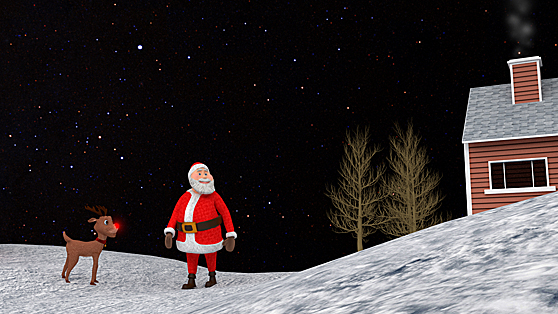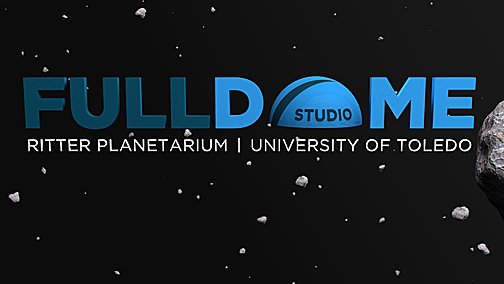The Ritter Planetarium at The University of Toledo has assembled a team of faculty, staff and students to create and produce fulldome planetarium programs.

This scene is from the UT Fulldome Studio’s program “Santa’s Secret Star,” which will premiere Friday, Dec. 5, at Ritter Planetarium.
Fulldome programs are primarily created by production houses and a handful of the largest planetariums in North America and Europe, and cost between $5,000 and $20,000 each. The quality of these programs varies tremendously and, unfortunately, many smaller and mid-sized digital planetariums cannot afford high-quality programs and are priced out of the fulldome market.
Ritter Planetarium has a library of approximately 20 such programs, with two or three being added each year. Fulldome programs are usually 20 to 25 minutes in length.
Creation of fulldome programs involves a large production crew, as opposed to the past when one-man shows were more common. Production costs can approach the level of TV series and films.
The University of Toledo Fulldome Studio utilizes talent from across campus: the Center for Creative Instruction, the Judith Herb College of Education, Art Department and more.
“We don’t have all of the needed talent on our small staff, but it occurred to us that UT, as a whole, does,” said Alex Mak, associate planetarium director. “This led us to create the UT Fulldome Studio. By combining our talent with that of others at UT, we have put together a production team that can produce high-quality programs for a reasonable cost. This will allow us to market our programs at a relatively low price.”
The UT Fulldome Studio is gearing up to release its first production titled “Santa’s Secret Star,” a 23-minute program for children in kindergarten through second grade. A teacher’s guide and other resources will help further the educational impact.
The program will premiere Friday, Dec. 5, at Ritter Planetarium.
“Santa’s Secret Star” is based on a traditional, slide-based planetarium program that Mak created in 1988.
“We’ve updated the script and have created a stunning visual adaptation,” he said.
 “Santa’s Secret Star” will be marketed to other planetariums throughout the United States. Revenue generated will be used to support Ritter Planetarium and future UT productions.
“Santa’s Secret Star” will be marketed to other planetariums throughout the United States. Revenue generated will be used to support Ritter Planetarium and future UT productions.
Mak noted that everyone involved in the project has learned a lot about what goes into a successful show.
“There are many elements to creating a good program. It has to be scientifically accurate and up-to-date. It has to be interesting, engaging and informative. Finally, it needs visual appeal,” Mak said. “The program has to take full advantage of the technological capabilities of modern projection systems.”
The UT Fulldome Studio crew already is planning the next production. They are hoping to create approximately two programs each year and sell the productions to 20 planetariums over a three-year period.
“Future productions will involve even more University students, faculty and staff, including writers, artists, musicians and educators,” Mak said.
Those involved in the production of “Santa’s Secret Star” include Morgan Hayward, recent UT graduate and graphic artist; Jason Bolbach, software specialist for the College of Natural Sciences and Mathematics, who provided the computer support needed to render the video; Dr. Lee Heritage, associate professor of music in the College of Communication and the Arts, who created a musical score; Paul Casmus, lead records technician II in the Radiology Department, who provided voice talent; and Cam Norton, assistant director of social media in University Communications, who provided audio engineering.
“UT Fulldome Studio is a terrific concept since it serves our need at the Ritter Planetarium for quality programs, serves the needs of the greater planetarium community, and provides positive exposure for the University,” Mak said. “It also gives our students an opportunity to gain valuable experience while at the same time generating much-needed revenue.”
For more information, visit utoledo.edu/nsm/rpbo.